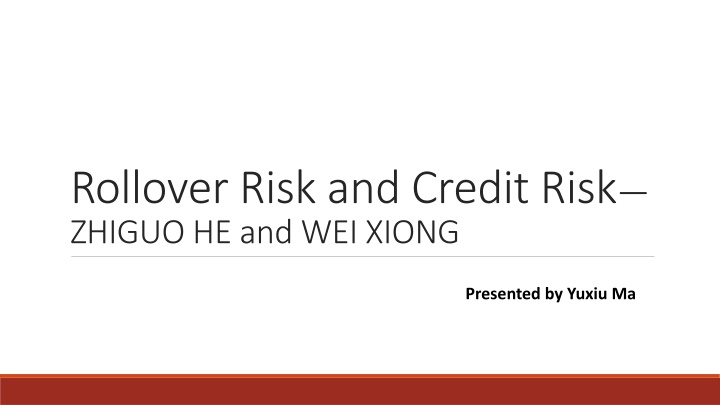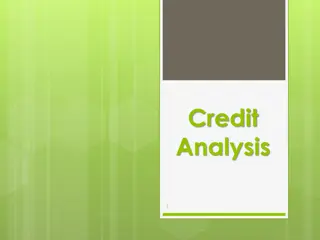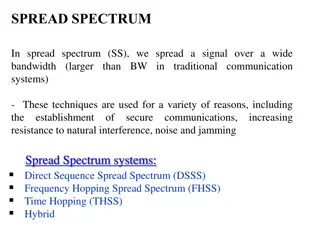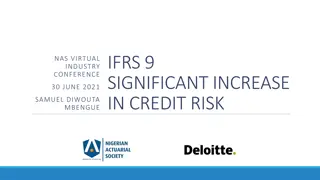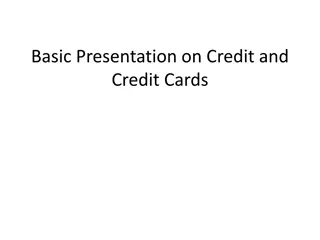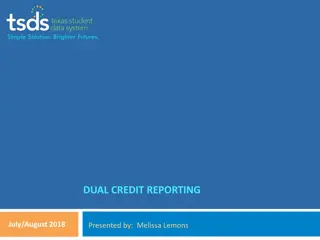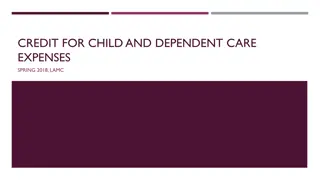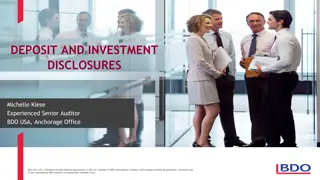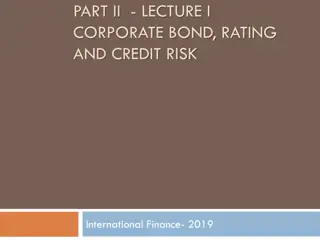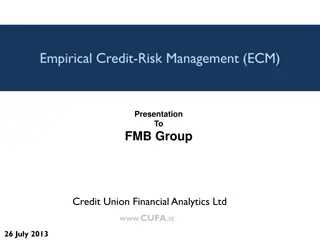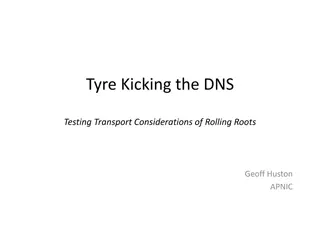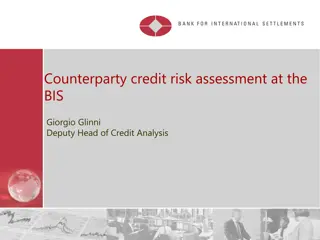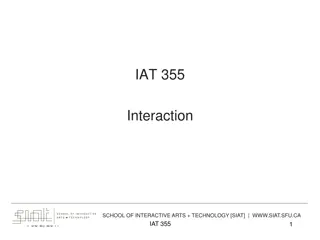Rollover Risk and Credit Spread Interaction
Introduction to the model exploring credit spread, liquidity premium, default premium, debt structure, debt rollover, bankruptcy dynamics, valuation, default boundary, equity value, market liquidity, and endogenous default in the context of rollover risk and credit risk.
Download Presentation

Please find below an Image/Link to download the presentation.
The content on the website is provided AS IS for your information and personal use only. It may not be sold, licensed, or shared on other websites without obtaining consent from the author.If you encounter any issues during the download, it is possible that the publisher has removed the file from their server.
You are allowed to download the files provided on this website for personal or commercial use, subject to the condition that they are used lawfully. All files are the property of their respective owners.
The content on the website is provided AS IS for your information and personal use only. It may not be sold, licensed, or shared on other websites without obtaining consent from the author.
E N D
Presentation Transcript
Rollover Risk and Credit Risk ZHIGUO HE and WEI XIONG Presented by Yuxiu Ma
AGENDA 1. Introduction 2. I. The Model 3. II. Valuation and Default Boundary 4. III. Market Liquidity and Endogenous Default 5. IV. Optimal Leverage . Conclusion 6. . My opinion 7.
Introduction Credit Spread reflects liquidity premium and default premium. Liquidity premium and default premium are not independent, but instead interact with each other. Deterioration in liquidity will increase default premium through rollover risk. This interaction originates from the conflict of interest of equity holders and debt holders. Shorter maturity for all bonds issued by a firm exacerbates its rollover risk
I. The Model A. Firm Assets B. Stationary Debt Structure we assume that the firm commits to a stationary debt structure denoted by (C, P, m). and expirations of the bonds are uniformly spread out over time. Each unit thus has a principal value of and an annual coupon payment of
I. The Model C. Debt Rollover and Endogenous Bankruptcy Vt *MODEL KEY FEATURE: The equity value is jointly determined by the firm s fundamental and expected future rollover gains/losses. D. Secondary Bond Markets Each bond investor is exposed to an idiosyncratic liquidity shock, which arrives according to a Poisson occurrence with intensity . Upon the arrival of the liquidity shock, the bond investor has to exit by selling his bond holding in the secondary market at a fractional cost of k.
II. Valuation and Default Boundary A. Debt Value two boundary conditions
II. Valuation and Default Boundary A. Debt Value the bond s value 8 the bond yield y Credit spread y-r
II. Valuation and Default Boundary B. Equity Value and Endogenous Default Boundary Boundary condition: VB: E (VB) = 0. PROPOSITION 1: The equity value E (Vt ) is given in equation (A7) of Appendix A. The endogenous bankruptcy boundary VB is given by
III. Market Liquidity and Endogenous Default Factors to change market liquidity over time. The effect of market liquidity shock on firms credit spreads. the bond s value 8
III. Market Liquidity and Endogenous Default A. Model Parameters
III. Market Liquidity and Endogenous Default B. Liquidity Premium and Default Premium PROPOSITION 2: All else equal, an increase in bond holders liquidity shock intensity decreases the firm s bond price and increases equity holders default boundary VB. Figure 2. Effects of bond investors liquidity demand intensity. This figure uses the base- line parameters listed in Table I. Panel A depicts equity holders aggregate rollover loss per unit of time, d(Vt,m;VB) p, which has the same scale as the firm s fundamental; Panel B depicts their default boundary VB; Panel C depicts the credit spread of the firm s newly issued bonds; and Panel D decomposes the credit spread into two components, the liquidity premium k and the remaining default premium. All the panels are with respect to .
III. Market Liquidity and Endogenous Default B. Liquidity Premium and Default Premium Under the different sets of parameters that are used to generate Figure 2, default damages the joint interest of debt and equity holders because even in the absence of any bankruptcy costs It is an issue of conflict of interest : When the bond price falls (even for liquidity reasons), equity holders have to bear all of the rollover losses to avoid default while maturing debt holders are paid in full.
III. Market Liquidity and Endogenous Default C. Amplification of Short-Term Debt A shorter debt maturity for the firm implies a higher rollover frequency. a higher rollover frequency forces equity holders to absorb a greater rollover loss per unit of time. This means a higher cost of keeping the firm alive, which in turn motivates equity holders to default at a higher fundamental threshold.
III. Market Liquidity and Endogenous Default C. Amplification of Short-Term Debt heavy use of short-term debt financing by many financial institutions leading up to the crisis. In the months preceding its bankruptcy, Lehman Brothers was rolling over 25% of its debt every day through overnight repos, a type of collateralized lending agreement with an extremely short maturity of 1 day. Short-term debt can significantly amplify a firm s rollover risk and make it vulnerable to shocks to bond market liquidity. Our model thus highlights firms debt maturity structure as an important determinant of credit risk.
III. Market Liquidity and Endogenous Default D. Calibration of Different Firms
IV. Optimal Leverage the debt market becomes more illiquid, the firm s default risk rises, which in turn motivates the firm to use lower leverage. it is optimal to use a lower leverage for shorter debt maturity.
V. Conclusions A model to analyze the effects of debt market liquidity on a firm s credit risk through its debt rollover. When a shock to market liquidity pushes down a firm s bond prices, it amplifies the conflict of interest between debt and equity holders because, to avoid bankruptcy, equity holders have to absorb the firm s losses from rolling over maturing bonds at the reduced market prices. Our model highlights the role of short-term debt in amplifying a firm s rollover risk
V. My opinion Mostly agree with the paper. But one part concerns me. Recall: Panel D decomposes the credit spread into two components, the liquidity premium k and the remaining default premium. All the panels are with respect to . Isn t setting the remaining to be default premium too discretional? Any other risk factors to identify? Collin-Dufresne, Goldstein, and Martin (2001) find that proxies for changes in the probability of future default based on standard credit risk models and for changes in the recovery rate can only explain about 25% of the observed changes in credit spread. On the other hand, they find that the residuals from these regressions are highly cross-correlated, and that over 75% of the variation in the residuals is due to the first principal component. The source of this systematic component still remains unclear. Our model sug- gests that aggregate shocks to the liquidity of bond markets are a possible candidate.
